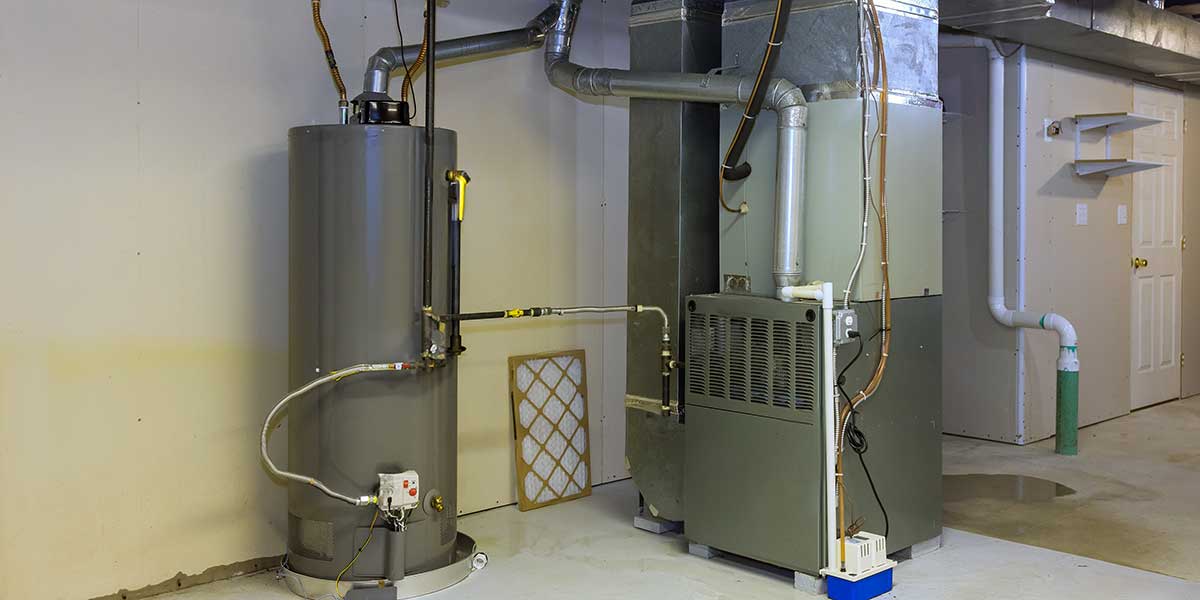Furnace size directly impacts how evenly your house warms and how much you spend to run it. If the unit is too small, it runs nonstop without ever reaching your set temperature. If it’s too large, it short cycles, wears out faster, and won’t heat your home evenly.
In this blog post, you’ll learn how HVAC professionals measure a home’s square footage, calculate BTU ratings, check home insulation, and run a Manual J load calculation to find the right furnace size. If you still need help answering, “What size furnace do I need?” after reading, call Chill Factor Cooling & Heating at 951-268-6520 to size and install a furnace for your home.
How Your Home’s Square Footage Affects Furnace Size
Professionals start by measuring your house. Square footage sets the baseline for any furnace calculation. Without it, you can’t size the system.
- In warmer regions, plan for 30–35 BTUs per square foot.
- In moderate regions, use 40–50 BTUs per square foot.
- In colder climates, expect 55–60 BTUs per square foot.
Example: A 2,000-square-foot home in a moderate climate needs about 80,000 BTUs. Larger homes need more BTUs and sometimes a more powerful furnace. Use this as your starting point before you factor in insulation, layout, and efficiency.
Manual J Load Calculation and Your BTU Rating
Square footage only provides a rough estimate. A Manual J calculation gives you the precise BTUs you need to heat your home.
A technician evaluates insulation, window type, ceiling height, roof construction, duct layout, and local weather data. Each factor affects heat loss and the amount of energy your furnace must produce. A Manual J load calculation shows you the exact BTUs your house needs.
Oversizing by even ten percent wastes energy and causes short cycling. Undersizing the unit causes it to run continuously but still fall short. When you schedule this calculation through Chill Factor Cooling & Heating, you receive a correctly sized furnace tailored to your specific layout.
BTU Ratings Explained
Think of heating water as a way to measure energy. If you take a single pound of water and warm it up by just one degree Fahrenheit, the energy required to do so is equivalent to one British Thermal Unit, or BTU.
If you’re asking, “What size furnace do I need?” you’re really asking how many BTUs your house requires. A higher BTU rating indicates greater heat and energy output. A larger furnace can be right for larger homes. A smaller furnace can be right for traditional small homes with tight envelopes. The ideal furnace size is the one that matches your load calculation.
How Home Insulation Changes the Furnace Size You Need
Before deciding on the size of furnace to install, consider your insulation. Insulation sets the pace for how fast your house loses heat. Poor insulation forces a furnace to work harder, driving up bills. Better insulation slows heat loss, allowing you to size the furnace correctly without overspending.
- Check attic insulation. If you see joist tops, add coverage.
- Inspect windows and doors for drafts or condensation.
- Seal gaps with weatherstripping and caulk.
- Replace older windows that leak heat.
Each upgrade reduces heat loss, lowers the BTUs your system needs, and cuts your energy bills.
How Efficiency Ratings Determine Furnace Size
Once you know your baseline, adjust for furnace efficiency. The efficiency rating indicates how much of the fuel is converted into usable heat. An 80-percent-efficient furnace loses about 20 percent of its fuel in exhaust, while a 95-percent-efficient furnace converts almost all of it into heat.
If your house needs 80,000 BTUs, an 80-percent furnace requires 100,000 BTUs to cover the loss. A 95-percent furnace only needs about 85,000 BTUs to reach the same output. Matching your BTU rating with both the load calculation and the efficiency rating ensures you select the right furnace size, preventing energy waste.
How Your Layout Affects the Furnace Size You Need
The layout of your house’s design directs airflow, which affects how much heat you need to maintain a comfortable temperature. Two houses with the same square footage can require different furnace sizes if one has an open layout and the other is divided into smaller rooms.
- Open floor plans allow air to circulate easily and may require fewer BTUs per square foot.
- Closed-off rooms and multiple floors need more heating power to balance hot and cold spots.
- You must count finished basements and attics if they connect to supply and return ducts.
When you’re answering, “What size furnace do I need?” don’t just stop at square footage. Account for how your home’s construction affects heating demand as well.
Common Signs Your Current Furnace Size Isn’t Correct
If your furnace is the wrong size, it’ll show up in how your house feels and how much you pay each month. Paying attention to these signs helps you catch sizing problems before you replace your system.
- An oversized furnace starts and stops often, pushes too much air, and drives higher energy bills.
- An undersized furnace runs for extended periods, misses the thermostat setting, and leaves cold spots.
- Hot and cold spots between floors or rooms point to airflow and size issues.
If you see these symptoms, you’re not dealing with the right size furnace. Replacing it with a correctly sized unit fixes uneven heating, lowers your bills, and keeps your home comfortable through the season.
Professional Furnace Installation That Locks In Performance
Even the right furnace size won’t work well if it’s installed incorrectly. At Chill Factor Cooling & Heating, licensed pros:
- Inspect duct sizing and airflow before placing the unit.
- Seal and insulate connections to prevent leakage.
- Verify delivered BTUs match the BTU rating.
- Balance supply and return to remove hot and cold spots.
- Confirm the furnace hits its efficiency rating under load.
Correct furnace installation protects equipment longevity, prevents short cycling, and reduces energy bills.
Call Chill Factor Cooling & Heating for Professional Furnace Sizing and Installation
If you’re still asking, “What size furnace do I need?” skip the guesswork and call Chill Factor Cooling & Heating at 951-268-6520. Our HVAC professional measures the square footage, runs the Manual J calculation, reviews key factors such as home insulation, layout, and other factors that affect the load, and then recommends a new furnace that suits your house.
Call Chill Factor Cooling & Heating at 951-268-6520 today to schedule professional furnace installation, heating maintenance, and other HVAC services.



